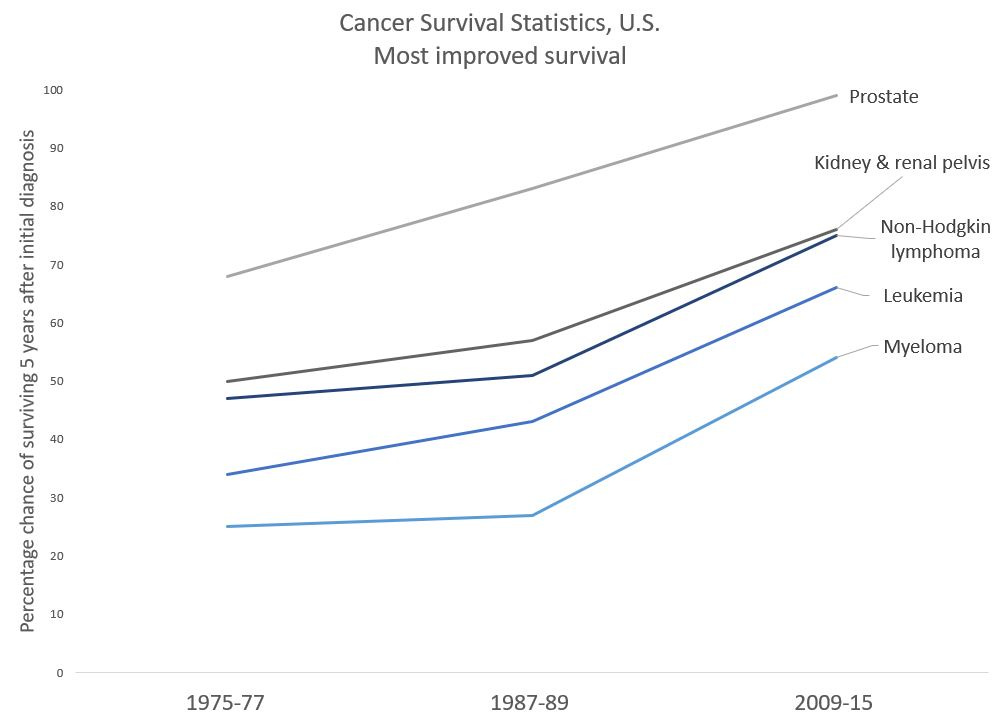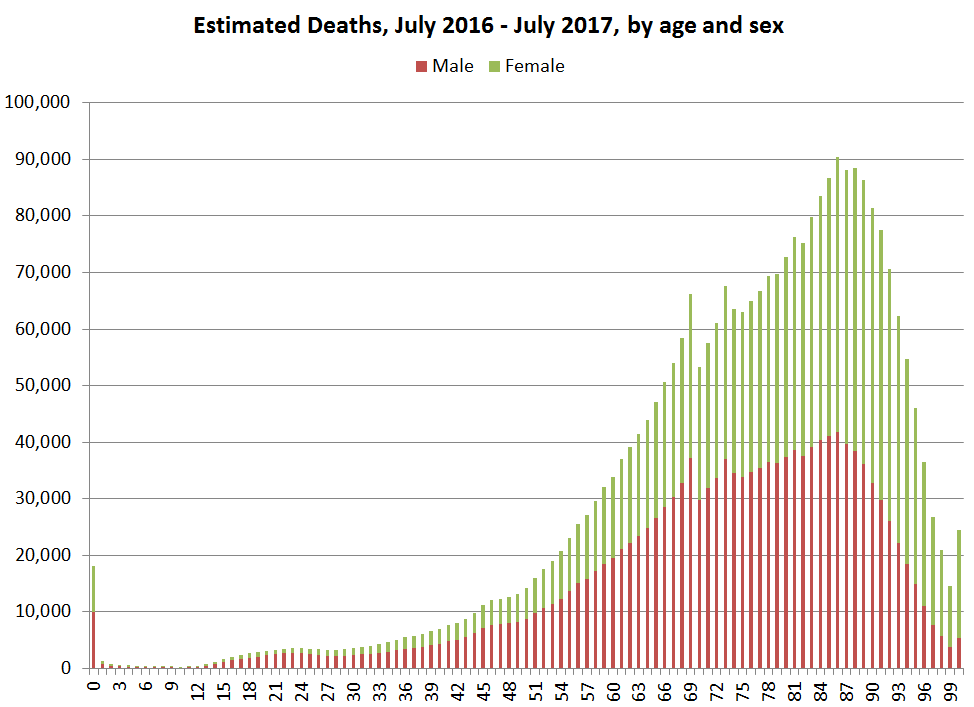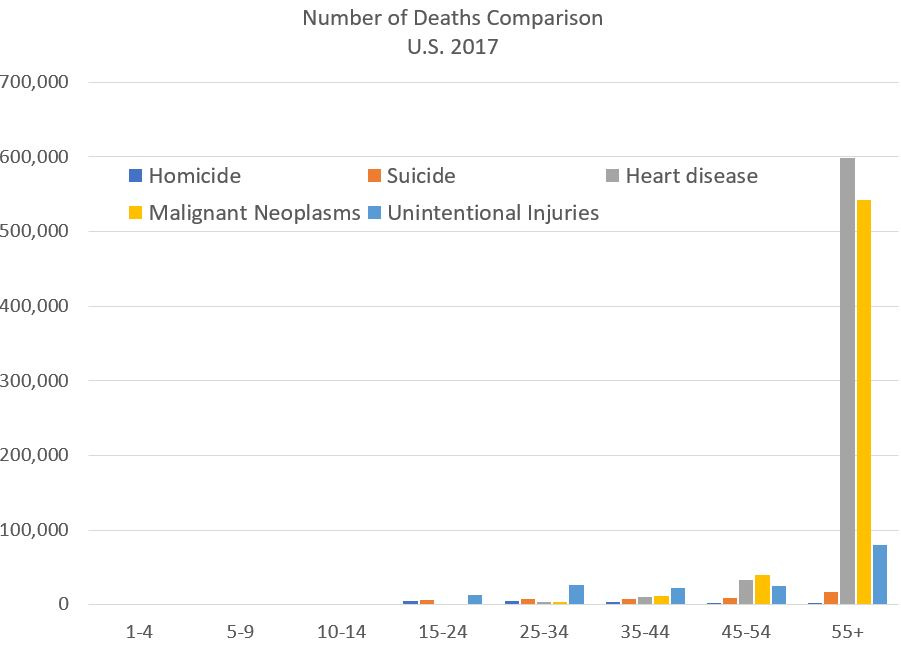Mortality with Meep: Retrospective on Mortality Trends (and a wee bit about COVID)
Don't fear the reaper. Quantify him.
As I mentioned in my prior post, for this week, as it looks like I have new readers, I want to give y’all a little taste of the themes on this blog.
Today’s is mortality.
It turns out my original post at STUMP is too long for substack, so go there to see the whoooole thing. I’ve had to cut explanatory text, a video, and sections to make this fit the substack system.
I’m a life actuary, which means I’m all about death.
Again, to be clear: I work in life insurance and annuities. I can’t help you with your car or home insurance. (Also, I don’t sell these products and can’t tell you which companies to buy from. I can give you basic information about types of products, yadda yadda)
I’m about death. DEAAAAAAATH
I’ve even done some videos about mortality.
I’ve got 77 posts in the mortality category (now 78).
Happy mortality news
At least with mortality, there is actually a lot of good news… at least in the pre-COVID days.
Child mortality, amazingly, has been improving worldwide and continuing to improve, even though it was already superlow.
Good News for Wednesday: The World is Getting Better
The 19th century was a rough time to live (or, in this case, not live). While there was some mortality improvement for children up til the Civil War, that diphtheria outbreak [late 1800s] caused disimprovement.
But check out 1930. From 1920 to 1930, there was an almost 50% improvement of mortality. Not a 25 year period, but a 10 year period. Child mortality dropped from about 17% to 9% over that period.
I didn’t point it out in this post, but look at the 2010 data point — even with child mortality as low as it currently is, with most kids dying from accidental causes, homicide (sorry, y’all), or cancer… there still was an over 10% improvement in mortality from 2000 to 2010. It still flabbergasts me. It’s not just breakthroughs with childhood cancer (which is rare, but because kids die so infrequently of any cause, it’s a top cause of child deaths), but a reduction in accidental deaths. YAY SAFETY!
Child mortality is not the only great improvement. Heart disease mortality has come way down.
In addition, cancer survivor rates have greatly improved, due to both better detection and treatment.
Mysterious Russian deaths and not-so-mysterious pension fraud deaths
[Yes, I’m starting with the light stuff…. to draw you into my dark side.]
Go to STUMP for Dominican Republic Deaths
Mortality Monday: Suspicious Russian Deaths
Male Russian life expectancy has sucked. Hard.
Russian men have a life expectancy of more than 10 years less than American men. That’s bigger than the black-white racial gap in life expectancy in the U.S. A lot bigger. Like, three times bigger.
A related post: Russian Retirement Age Raised Past Death? Let Me Actuary-splain…
The weirdest one of all: Mortality with Meep: How to Get Lots of Supercentenarians? Pension fraud!
It involves an amusing story about pension fraud in Japan, where the person got caught out because he “officially” became the world’s oldest living man…. except for the fact he had died decades earlier. I’m not joking – he had died over 30 years earlier.
Political mortality
I started doing this before this blog. In September 2008, I calculated John McCain’s life expectancy (on my livejournal). It links to things that no longer exist, but here were the results:
Survival probabilities for 72-year-old man:
to age 77: 87.7%
to age 81: 74.5%
McCain was 81 at death, in 2018. Of course, considering the stresses of office, he may not have survived two Presidential terms, had he been elected President and then re-elected.
I’ve done more calculations of both survivorship probabilities for Presidents and Supreme Court Justices since that 2008 post.
August 2015: Presidential Interlude: What are the Chances? – that was when the oldest candidate was Bernie Sanders, at age 74. Now (in 2020), Trump is 74 and Biden is 77.
September 2016:Actuarial Nuggets: Public Pensions and Financial Economics, Presidential Mortality, and More
February 2017: Mortality Monday: Supreme Court Probabilities
April 2017: Mortality Monday (with a little Trumpery): Supreme Court Probabilities Take 2
July 2018: Supreme Court Mortality Projection Update!
February 2019: Presidential Mortality: Bernie Running and Link to Retirement Planning
January 2020: Presidential Mortality: 2020 Update — These Candidates are Old
March 2020: Presidential Mortality: Evaluating a Biden-Sanders Ticket – obviously, this didn’t happen. Kamala Harris is very unlikely to die in the next 8 years, so this is all moot.
General U.S. mortality
Being in the U.S., I spend a lot of time thinking and writing about our mortality trends. I predict and also look backwards.
In February 2017 I posted: Mortality Monday: How Many People Will Die in the U.S. in 2017? – that was from February 2017. Here was my graph:
Looks like I didn’t link my spreadsheet, but I just grabbed death data from WONDER at the CDC for 2017. I had estimated about 2.9 million Americans died from July 2016 – June 2017, but I’m going to shift it for January 2017 – December 2017 (because it’s simpler).
=squint= well, the shape is right, but it looks like I got my base wrong somehow, because the actuals are lower than the projected. Maybe the projected mortality rates were too high.
Mortality with Meep: Top Causes of Death – Raw Numbers
A few graphs from that one:
Those are not rates. Those are the actual numbers of 2017 U.S. deaths by causes. A lot of people have no clue, getting very hung up on rare causes of death.
Some more U.S. trends:
RIP, Boomers: Death Comes For Us All – inspired by the deaths of Lemmy from Motorhead, David Bowie, Alan Rickman, and Glenn Frey, all of who died near each other in time.
Death Comes for Us All, Part 2: Expect the Wave (that will take decades)
Mortality Monday: When Do People Die? – this is about month and day-of-the-week for deaths.
Mortality with Meep: Baseline U.S. Mortality Stats for Comparison
COVID-19 mortality
Before I post COVID-related mortality, look at this post from October 2018: Get A Flu Shot: Last Year’s Seasonal Flu Was the Worst in 40 Years
“An estimated 80,000 Americans died of flu and its complications last winter, according to the US Centers for Disease Control and Prevention. This means it was the deadliest season in more than four decades — since 1976, the date of the first published paper reporting total seasonal flu deaths, said CDC Spokeswoman Kristen Nordlund.”
…..Check out that spike. Even with some relatively nasty flu seasons, we have never gotten near anything like the Spanish flu pandemic since 1918. And that pandemic has nothing on what the Black Death was like.
By the way, we are still nowhere near 1918 Spanish flu pandemic levels for mortality, and I would hope not given it’s a century later. There are huge differences in the mortality patterns of the 1918 pandemic and the current one, the biggest difference being the age profile of those dying of COVID-19 being skewed very old, where the 1918 pandemic was skewed more towards young adult mortality.
2 March 2020: Pandemic: Current Stats of COVID-19, Spanish Flu, and WASH YOUR HANDS
April 2020: Know Your Models: COVID-19 . Right now, I just want to note that nobody is looking at these models in September 2020. Isn’t that interesting? Think about why. (Simple: these models have performed horribly)
21 April 2020: Mortality with Meep: Excess Deaths And Coronavirus
7 May 2020: Mortality with Meep: Excess Deaths and COVID-19
3 August 2020: Mortality with Meep: On Florida COVID Deaths and Reporting Lag
27 August 2020: Mortality with Meep: U.S. Excess Deaths Related to Covid Update to August 27, 2020
Miscellaneous Mortality Geekery
Alas, I had to cut most of this. Please go to the full STUMP post for other links.
I understand my particular interest in mortality trends may not be to the taste of most, but don’t worry: I put it right in the title, so you can easily skip the mortality posts.
Enjoy!












